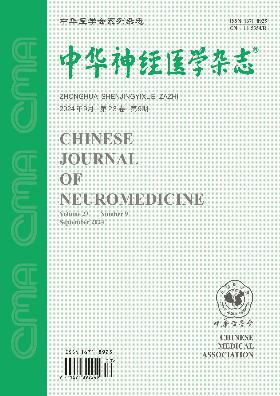Endovascular recanalization in non-acute symptomatic occlusion of the ophthalmic segment of internal carotid artery
Q4 Medicine
引用次数: 0
Abstract
Objective To investigate the safety, efficacy and feasibility of endovascular recanalization in non-acute symptomatic occlusion of the ophthalmic segment of internal carotid artery, and analyze the factors affecting its success. Methods Fifty-four patients with non-acute symptomatic occlusion of the ophthalmic segment of internal carotid artery, underwent endovascular recanalization in our hospital from January 2013 to December 2017, were enrolled. Modified Rankin scale (mRS) and National institutes of health stroke scale (NIHSS) scores were compared before and after treatment; the prognosis results were analyzed after 2 years of follow-up. Independent factors influencing the prognoses were identified by Logistic regression analysis. Results Recanalization was achieved in 52 patients and failure was noted in two patients. The mRS scores and NIHSS scores before treatment (2.25±0.13, 18.43±1.36) were significantly higher than those after treatment (1.44±0.05, 11.81±0.71, P<0.05). After 2 years of follow-up, good prognosis was noted in 42 patients, poor prognosis in 8 patients, and loss of follow-up in 2 patients. Multivariate Logistic analysis showed that history of hypertension and history of diabetes were independent risk factors for the prognoses of patients with non-acute symptomatic occlusion of the ophthalmic segment of internal carotid artery after endovascular recanalization (OR=1.429, 95CI: 1.146-1.783, P=0.005; OR=2.597, 95CI: 2.364-2.854, P=0.005). Conclusion The curative effect of interventional therapy for non-acute occlusion of symptomatic internal carotid artery is reliable, and histories of hypertension and diabetes can affect the prognoses of patients. Key words: Interventional recanalization; Internal carotid artery occlusion; Prognosis; Clinic非急性症状性颈内动脉眼段闭塞的血管内再通
目的探讨血管内再通治疗非急性症状性颈内动脉眼段闭塞的安全性、有效性和可行性,并分析影响其成功的因素。方法选取2013年1月至2017年12月在我院行血管内再通术的非急性症状性颈内动脉眼段闭塞患者54例。比较治疗前后修正Rankin量表(mRS)和美国国立卫生研究院卒中量表(NIHSS)评分;随访2年后对预后结果进行分析。通过Logistic回归分析确定影响预后的独立因素。结果52例成功再通,2例失败。治疗前mRS评分和NIHSS评分分别为2.25±0.13、18.43±1.36,显著高于治疗后的1.44±0.05、11.81±0.71,P<0.05。随访2年后,预后良好42例,预后差8例,失访2例。多因素Logistic分析显示,高血压史和糖尿病史是影响血管内再通术后非急性症状性颈内动脉眼段闭塞患者预后的独立危险因素(OR=1.429, 95CI: 1.146 ~ 1.783, P=0.005;Or =2.597, 95ci: 2.364-2.854, p =0.005)。结论介入治疗非急性症状性颈内动脉闭塞疗效可靠,高血压、糖尿病病史会影响患者预后。关键词:介入再通;颈内动脉闭塞;预后;诊所
本文章由计算机程序翻译,如有差异,请以英文原文为准。
求助全文
约1分钟内获得全文
求助全文
来源期刊

中华神经医学杂志
Psychology-Neuropsychology and Physiological Psychology
CiteScore
0.30
自引率
0.00%
发文量
6272
期刊介绍:
 求助内容:
求助内容: 应助结果提醒方式:
应助结果提醒方式:


